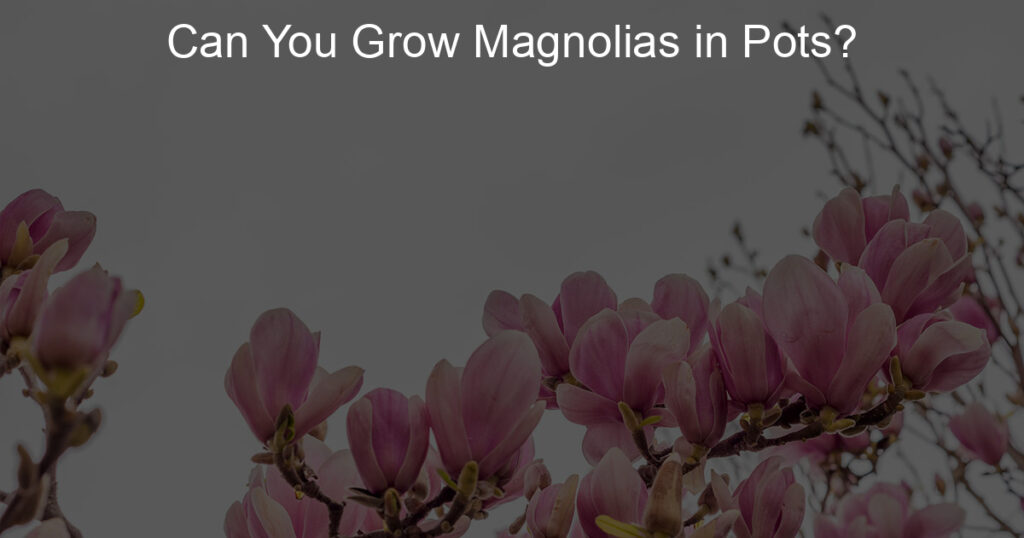Magnolias are one of the most popular tree flowering shrubs for privacy and shade. They can also add flair to your front yard. These plants grow best in moist soil with a pH level of 6.5-7.5. Even though they thrive in full sun, they can grow well in semi-shade or partial shade as well.
Magnolias donג€™t require much care once theyג€™re planted. However, they do need regular watering and fertilization to stay healthy and produce flowers all season long. Read on to learn more about planting magnolias in pots, care guidelines, soil preparation, and when itג€™s the right time to transplant them outside if you plan to grow them at home instead of inside a greenhouse or as an ornamental plant for your yard.
Which Magnolias Are Best for Pots?
Magnolia trees that are good for pots include the Southern magnolia, Japanese magnolia, and weeping magnolia. All three of these plants have large leaves that can be used as a background for other plants or to help shield your home from harsh sun rays. They also grow easily and are appropriate for both indoor and outdoor settings. The Southern magnolia is the most common variety of this plant in the United States. It has delicate petals with a strong fragrance that makes it a popular choice for weddings, parties, and other events where people need an elegant showpiece with a pleasant aroma to recommend it.
When choosing which variety of magnolias to grow in pots, consider planting one of these three if you want an easy-to-care-for plant that will add height and beauty to your yard or garden.
How Do You Take Care of a Potted Magnolia Tree?
In order to take care of a potted magnolia tree, you will need to monitor the soil moisture and sunlight requirements. If you see that your plant is wilting, it may be because the soil isnג€™t moist enough. Make sure that the soil is moist before watering the plant again or else it could cause root rot.
Magnolias also require full sun in order to bounce off energy from the sun during the day and to grow strong leaves. If you plan on placing them in semi-shade or partial shade, make sure they are planted in a location where they will get at least six hours of direct sunlight per day.
Keep your magnolia plant healthy by fertilizing it once every other month with composted manure or compost tea. To help prevent disease, use an organic pest control product when necessary. On average, these plants grow best with a pH level of 6.5-7.5, so adjust your soil mixture accordingly if you notice that your plant is growing too tall for its pot without absorbing enough nutrients from the soil.
Can My Potted Magnolia Tree Die?
If your magnolia tree is dying, the first step to take is to figure out whatג€™s causing it. If you have a sick tree, it needs more attention than simple watering and fertilizing. In order to avoid infection or disease, itג€™s best to make sure your plants are healthy and disease-free. If you find that the flowers are dropping from your plant, then this could be a symptom of some type of plant disorder or fungus. However, if the leaves or branches are turning brown and looking dry, then this could also be a sign of a fungal disease.
So how can you tell if your pot magnolia has died? One way is by checking for signs of breathing or movement in their leaves. If the leaves are still green and alive, then theyג€™re likely in good shape and will eventually recover from any illness if you give them enough care. However, if the leaves turn brown despite being watered regularly and fertilized with fresh soil then you might want to dig up your plant and replant it elsewhere so that it can recover.
What Do Magnolias Need To Survive?
One of the most important steps in planting a magnolia is finding out what the plant needs to survive. For starters, they need well-drained soil with a pH level of 6.5-7.5. The best place to plant them is where you donג€™t have any other trees growing nearby, as this will prevent them from competing for nutrients and water with the magnolias. Additionally, these plants need direct sun and regular watering to grow strong and healthy. One care guideline to follow is to place an inch or two of compost on top of their root ball when you plant them in a pot. This will help the plant develop deep roots that can handle more moisture and nutrients than the surface roots that are usually exposed at first.
In terms of size, magnolias can grow up to 30 feet tall if left unpruned for years or if given enough time for them to establish themselves as full trees instead of shrubs. However, you should always prune your magnolia bush so that it grows equally on both sides and doesnג€™t become too large or invasive for your yard space. You should also prune around one foot off of the bottom stem after one year so that it will produce new branches faster than it would otherwise in order to keep your tree balanced while still being aesthetically pleasing.














